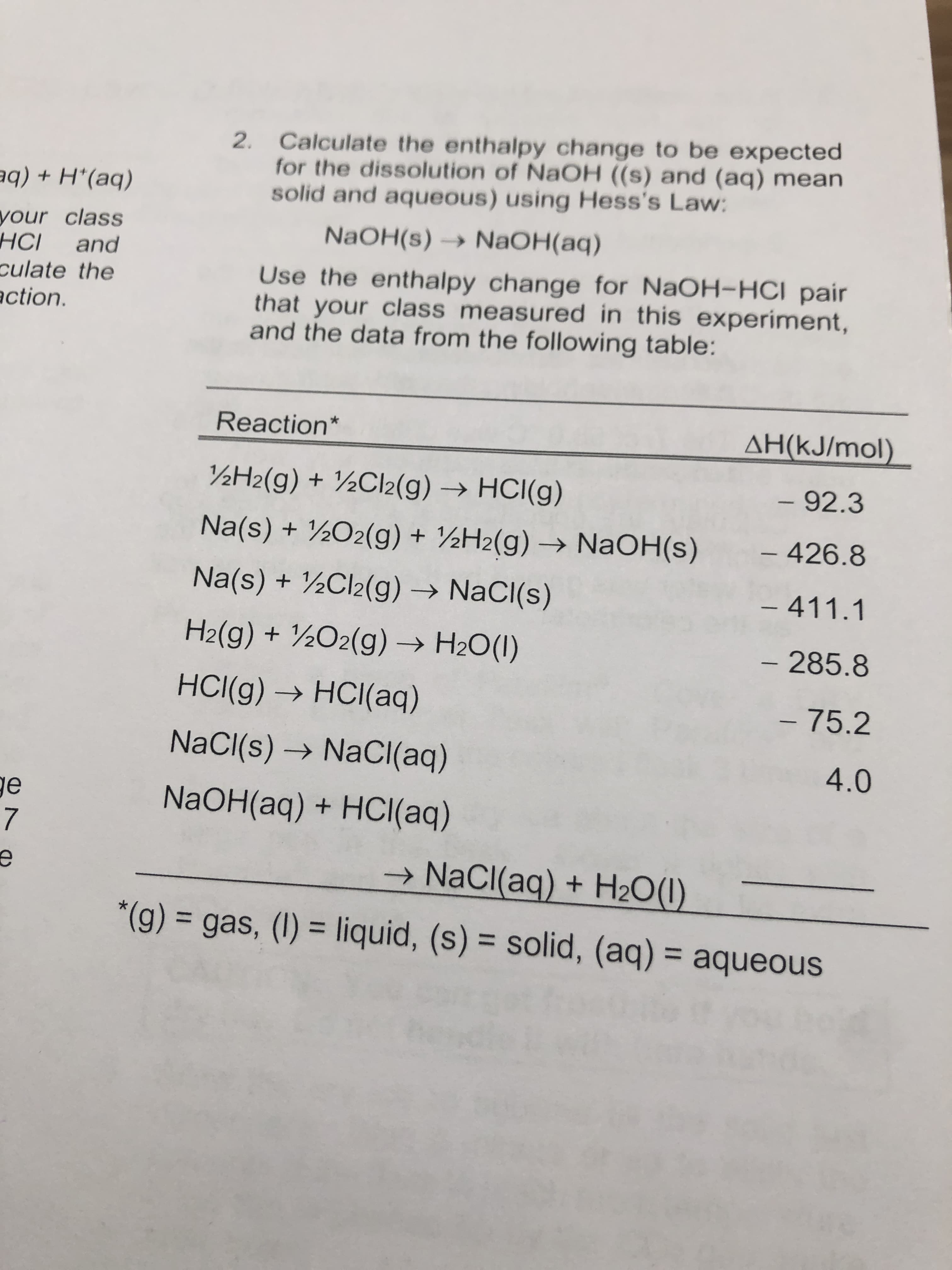2. Calculate the enthalpy change to be expected for the dissolution of NaOH ((s) and (aq) mean solid and aqueous) using Hess's Law: q + H*(aq) your class and NaOH(s) → NAOH(aq) НСІ culate the action. Use the enthalpy change for NaOH-HCI pair that your class measured in this experiment, and the data from the following table: Reaction* AH(kJ/mol) ½H2(g) + ½CI2(g) → HCI(g) - 92.3 Na(s) + ½O2(g) + ½H2(g) → NaOH(s) –426.8 Na(s) + ½CI2(g) → NaCI(s) – 411.1 H2(g) + ½O2(g) → H2O(1) - 285.8 HCI(g) → HCI(aq) -75.2 NaCI(s) → NaCI(aq) 4.0 NaOH(aq) + HCI(aq) → NaCl(aq) + H2O(1) *(g) = gas, (1) = liquid, (s) = solid, (aq) = aqueous %3D %3D %3D
2. Calculate the enthalpy change to be expected for the dissolution of NaOH ((s) and (aq) mean solid and aqueous) using Hess's Law: q + H*(aq) your class and NaOH(s) → NAOH(aq) НСІ culate the action. Use the enthalpy change for NaOH-HCI pair that your class measured in this experiment, and the data from the following table: Reaction* AH(kJ/mol) ½H2(g) + ½CI2(g) → HCI(g) - 92.3 Na(s) + ½O2(g) + ½H2(g) → NaOH(s) –426.8 Na(s) + ½CI2(g) → NaCI(s) – 411.1 H2(g) + ½O2(g) → H2O(1) - 285.8 HCI(g) → HCI(aq) -75.2 NaCI(s) → NaCI(aq) 4.0 NaOH(aq) + HCI(aq) → NaCl(aq) + H2O(1) *(g) = gas, (1) = liquid, (s) = solid, (aq) = aqueous %3D %3D %3D
Chemistry: Principles and Practice
3rd Edition
ISBN:9780534420123
Author:Daniel L. Reger, Scott R. Goode, David W. Ball, Edward Mercer
Publisher:Daniel L. Reger, Scott R. Goode, David W. Ball, Edward Mercer
Chapter12: Solutions
Section: Chapter Questions
Problem 12.4QE
Related questions
Question
100%

Transcribed Image Text:2. Calculate the enthalpy change to be expected
for the dissolution of NaOH ((s) and (aq) mean
solid and aqueous) using Hess's Law:
q + H*(aq)
your class
and
NaOH(s) → NAOH(aq)
НСІ
culate the
action.
Use the enthalpy change for NaOH-HCI pair
that your class measured in this experiment,
and the data from the following table:
Reaction*
AH(kJ/mol)
½H2(g) + ½CI2(g) → HCI(g)
- 92.3
Na(s) + ½O2(g) + ½H2(g) → NaOH(s)
–426.8
Na(s) + ½CI2(g) → NaCI(s)
– 411.1
H2(g) + ½O2(g) → H2O(1)
- 285.8
HCI(g) → HCI(aq)
-75.2
NaCI(s) → NaCI(aq)
4.0
NaOH(aq) + HCI(aq)
→ NaCl(aq) + H2O(1)
*(g) = gas, (1) = liquid, (s) = solid, (aq) = aqueous
%3D
%3D
%3D
Expert Solution
This question has been solved!
Explore an expertly crafted, step-by-step solution for a thorough understanding of key concepts.
This is a popular solution!
Trending now
This is a popular solution!
Step by step
Solved in 2 steps with 2 images

Recommended textbooks for you

Chemistry: Principles and Practice
Chemistry
ISBN:
9780534420123
Author:
Daniel L. Reger, Scott R. Goode, David W. Ball, Edward Mercer
Publisher:
Cengage Learning

General Chemistry - Standalone book (MindTap Cour…
Chemistry
ISBN:
9781305580343
Author:
Steven D. Gammon, Ebbing, Darrell Ebbing, Steven D., Darrell; Gammon, Darrell Ebbing; Steven D. Gammon, Darrell D.; Gammon, Ebbing; Steven D. Gammon; Darrell
Publisher:
Cengage Learning

Principles of Modern Chemistry
Chemistry
ISBN:
9781305079113
Author:
David W. Oxtoby, H. Pat Gillis, Laurie J. Butler
Publisher:
Cengage Learning

Chemistry: Principles and Practice
Chemistry
ISBN:
9780534420123
Author:
Daniel L. Reger, Scott R. Goode, David W. Ball, Edward Mercer
Publisher:
Cengage Learning

General Chemistry - Standalone book (MindTap Cour…
Chemistry
ISBN:
9781305580343
Author:
Steven D. Gammon, Ebbing, Darrell Ebbing, Steven D., Darrell; Gammon, Darrell Ebbing; Steven D. Gammon, Darrell D.; Gammon, Ebbing; Steven D. Gammon; Darrell
Publisher:
Cengage Learning

Principles of Modern Chemistry
Chemistry
ISBN:
9781305079113
Author:
David W. Oxtoby, H. Pat Gillis, Laurie J. Butler
Publisher:
Cengage Learning

Chemistry & Chemical Reactivity
Chemistry
ISBN:
9781337399074
Author:
John C. Kotz, Paul M. Treichel, John Townsend, David Treichel
Publisher:
Cengage Learning

Chemistry & Chemical Reactivity
Chemistry
ISBN:
9781133949640
Author:
John C. Kotz, Paul M. Treichel, John Townsend, David Treichel
Publisher:
Cengage Learning

Chemistry: The Molecular Science
Chemistry
ISBN:
9781285199047
Author:
John W. Moore, Conrad L. Stanitski
Publisher:
Cengage Learning